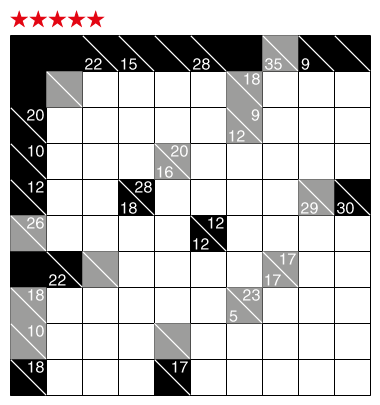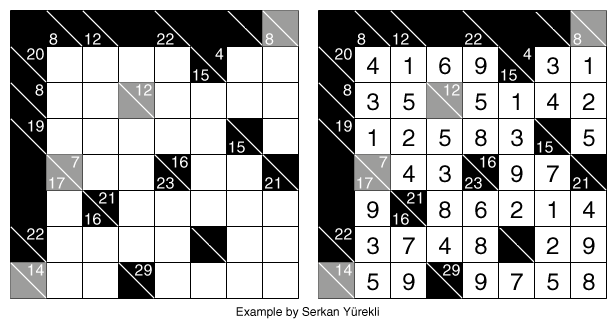Sunday Stumper: Kakuro (Subset) by Prasanna Seshadri
This year, we have started to have some extra difficult Sunday Stumpers, about once a month. These will be quite tough puzzles, but with a logical path to be found (and solution videos to help). This sixth Sunday Stumper is a Kakuro puzzle with some extra clue shadings to indicate connected digit subsets for some of the entries.

or solve online (using our beta test of Penpa-Edit tools)
Theme: Eye
Author/Opus: This is the 209th puzzle from our contributing puzzlemaster Prasanna Seshadri.
Rules: Standard Kakuro Rules. Also, whenever two multi-digit entries intersect and the set of digits in one entry is a subset of the set of digits in the other entry, the cell preceding each of those entries (either giving the entry’s clue or indicating that the entry is unclued) is shaded in gray. A shaded cell may be shaded because of its Across entry, Down entry, or both. Any clue cell that is not shaded does not have a multi-digit entry intersecting its Across or Down entries with a shared subset of digits. Any set of digits is considered a subset of itself.
See also this example:

Difficulty: 5 stars
Time Standards (highlight to view): Grandmaster = 20:00, Master = 30:00, Expert = 1:00:00
Solution: PDF; a solution video is also available here.
Note: Follow this link for classic Kakuro and this link for Kakuro variations. More Kakuro puzzles can be found in Kakuro and Variations by Serkan Yürekli and in The Art of Puzzles 2.

In the post image/PDF, it would be good to have the diagonal line printed on the two pure black cells on the top row (next to the 15 and the 9).
Since the gray cells always have the diagonal line, even if they don’t contain any numbers, I spent a *long* time thinking the pure black cells simply didn’t provide any information, rather than assuming the subset rule also applied to those as well.
(Of course, if I’d been solving this in Penpa, I’d have realized this much sooner, since the line *is* present there – but for once, I wasn’t…)
We’ve updated the example and PDF/PNG to make this very clear. Thanks for the feedback.